LP12MF Listening Test: Mober Subchassis for Linn
In the latest edition of the LP12 Modification Frenzy, I replace a Linn Kore subchassis with a Mober subchassis for Linn. You can check out my listening methodology. Full listening impressions on the Mober subchassis are below, as is a summary of the installation process. Digestible, numerical summaries of all my listening tests are here.
tl;dr
At the end of my listening test with the Kore and Ekos combination, I was left with a big question: why did a fancy tonearm, a fancy cartridge, and a pretty fancy subchassis not produce better sound than the budget-oriented Nima tonearm, Adikt cartridge, and Mober subchassis they replaced? I had a bunch of theories (on which, more below), but one of the leading theories was that my Kore subchassis — which has a mysterious bend in the armboard — was at least partially responsible, either because of that bend or because its mixed construction of machined armboard + screwed and glued aluminum sheet doesn’t sound as good as the Mober’s one-piece aluminum construction. So without delay, the day that I finished my listening tests for the previous round, I removed the Kore and installed a Mober subchassis cut for a Linn arm. (Disclosure: Edmund of Mober sent me a review unit at his own expense.)
The Mober subchassis made a large positive improvement in the system. The overall profile of the XX-2/Ekos combination — bass-heavy, full, rich, with lots of slam and impact — didn’t change, but the Mober definitely “tightened” the sound and gave back some of the “springiness” and vitality to the sound that I’d been missing since Round Five. According to my ranking method, the Mober subchassis improved things by 5.8%.
In my system, there’s no doubt: the Mober sounds much better than the Kore. Given that it is significantly cheaper than the Kore, and given the apparent issues with quality control on the Kore, I wouldn’t hesitate to strongly recommend the Mober over the Kore.
I’m still left wondering why this setup — with the expensive Ekos and XX-2 — remains 0.4% behind the best sound I’ve ever experienced. Many possibilities present themselves. But I did begin to wonder during this round whether the digital was perhaps sounding better than usual, perhaps because of a Roon software update or because I’d installed a power conditioner to eliminate AC noise introduced by power line networking; perhaps that had advantaged the digital over the vinyl source.
Whatever the case, I often had the sense during these listening tests that tracks were sounding better in absolute terms with this setup than I’d ever heard them before, yet in comparison to the digital the differences were not as wide as I’d reported. Overall, I’d say I think this system sounds as good or maybe a little bit better than the Mober subchassis/Nima/Adikt combination that garnered the highest scores in Round Five — though I’d expect it sound much better, given the massive difference in price between the Nima versus the Ekos and Adikt versus the XX-2. So still some open questions.
Installing the Mober subchassis
I’ve already written a detailed post on installing the Mober subchassis cut for Rega arms. It’s pretty much the same process for the Mover subchassis cut for Linn arms, so I won’t go over it in detail.
There is one little difference worth noting. The cutout for the Ekos arm base is a bit loose on the Mober subchassis; there is quite a bit of wiggle room for the the base in the cutout. The same is true of the cutouts for the mounting bolts. Thinking it was critical to get the distance between the bearing and the tonearm pivot spot-on, I wanted to make sure I had it centred in the cutout. I did so by wrapping a bit of tape around the arm base, which provided a tight fit and located the arm base right in the centre of the cutout. But thinking more about it, I don’t think the precise location of the arm in the cutout actually matters all that much, given that you adjust the cartridge in the headshell anyway. Still, nice to have it centred and secure.
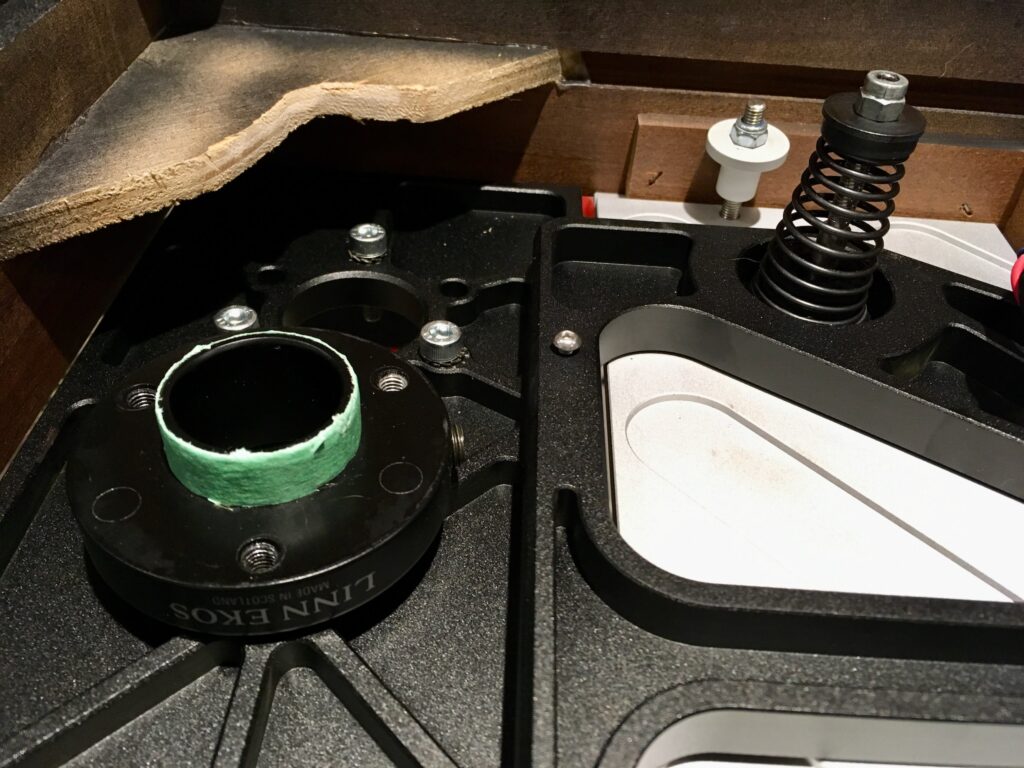
One slight drawback of the Mober design is that it makes it difficult to adjust the suspension by twisting grommets. This grommet-twisting is the main way of fine-tuning “bounce” and getting the desired “pistonic” movement. Because there is a large ridge around the grommet attachment point on the Mober (as you can see in the photo above), you need to work harder to twist the grommets than on subchassis like the Kore, Keel, and Klone, all of which are flat at the attachment points. With the Mober, you need to grab the spring and the the top of the grommet together and twist.
I was interested to see if I’d have to adjust the cartridge alignment in the Mober versus the wonky, bent Kore. So I got out the Best Tractor and all the associated loupes and lights.
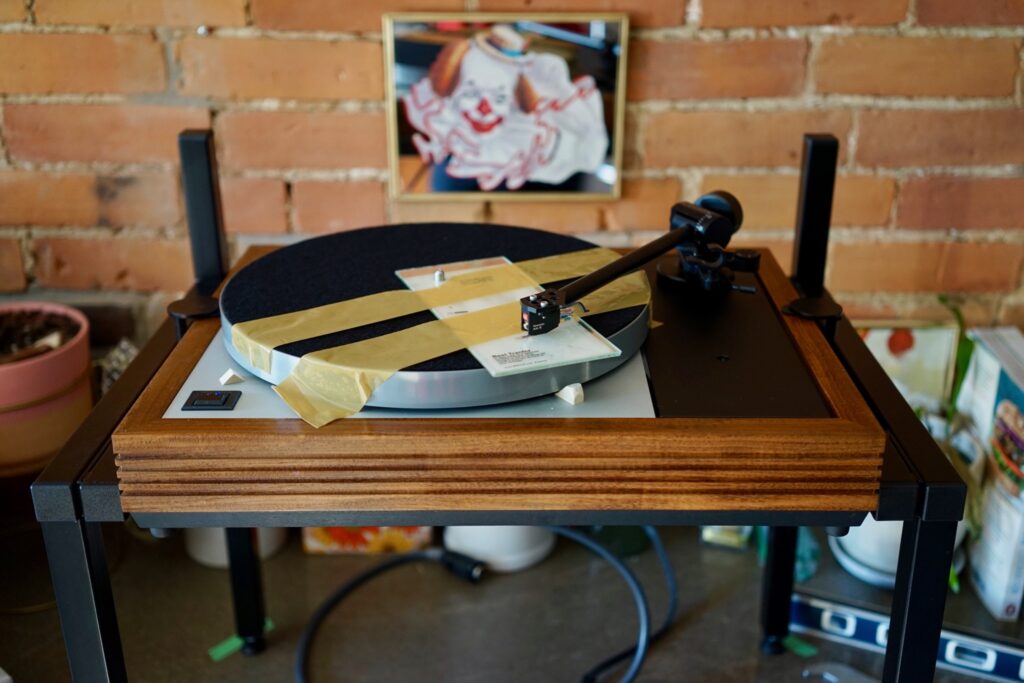
Indeed, I did need to adjust the cartridge in the headshell: it needed to move forward in the headshell and the tracking angle changed a tiny bit. I’d like to take this as proof that the bearing and tonearm were not being kept properly in line with one another in the Kore, causing mis-tracking, and possibly explaining the underwhelming performance of the last round — because I am positive that I had the alignment dialed in last time. But it may just be that the slightly loose mounting hole for the arm collar in the Mober subchassis located the arm a little further from the bearing, and called for some compensating adjustments.
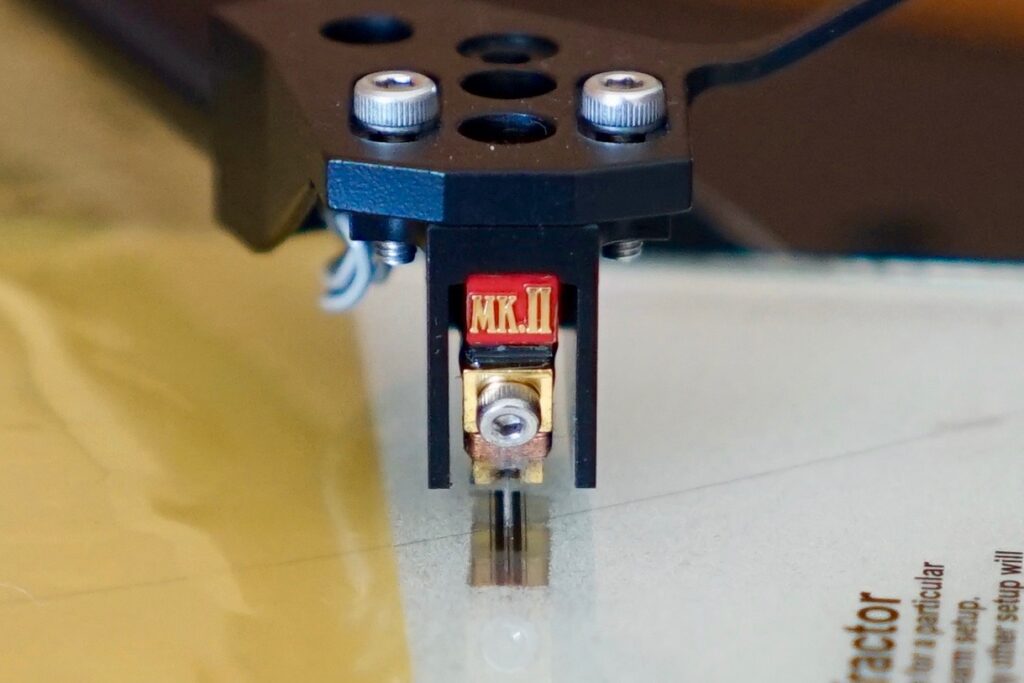
Above is my latest effort at photographing what you’re meant to see in the Best Tractor: with the thick black lines perfectly mirrored to indicate a correct viewing angle, the stylus should be perfectly centred between them. (Also, don’t worry, I cleaned out the accumulated dust on the cartridge coil after taking this photo.)
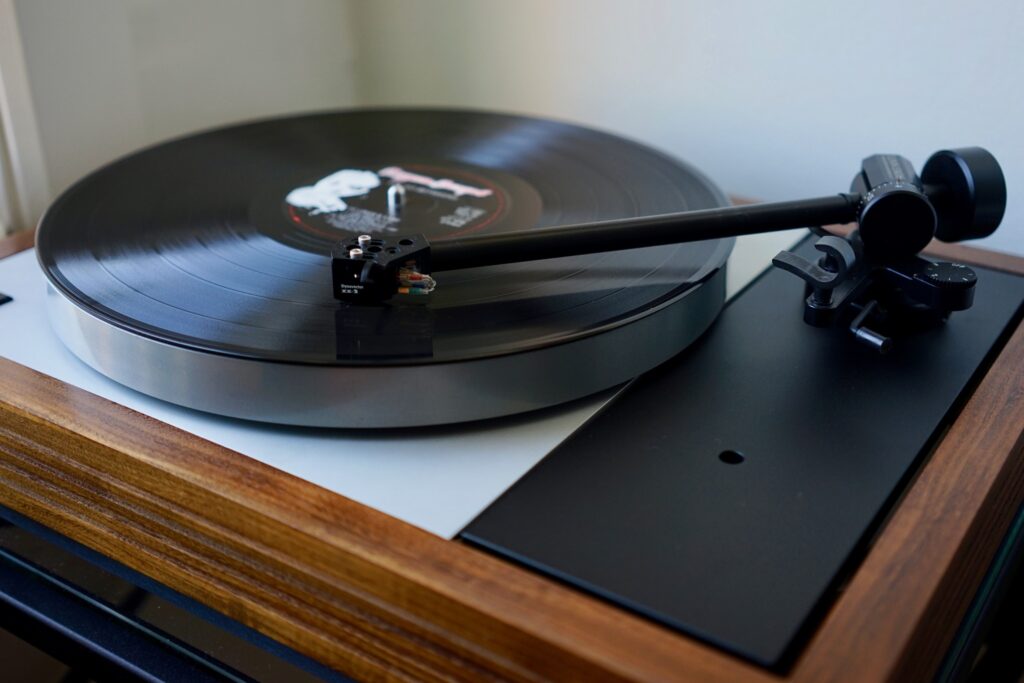
The finish on this Mober subchassis is identical to that on the previous one. Unlike the Linn Keel or the Greenstreet Klone, the surface of the armboard isn’t polished smooth. It has a rougher texture akin to the case on my olive Naim Nait 2. Whether this is a good or a bad thing is up to you. I’m actually quite fond of the way it looks — I prefer it to the sparkly dark-grey finish on the Kore, definitely, which strikes me as sort of tacky.
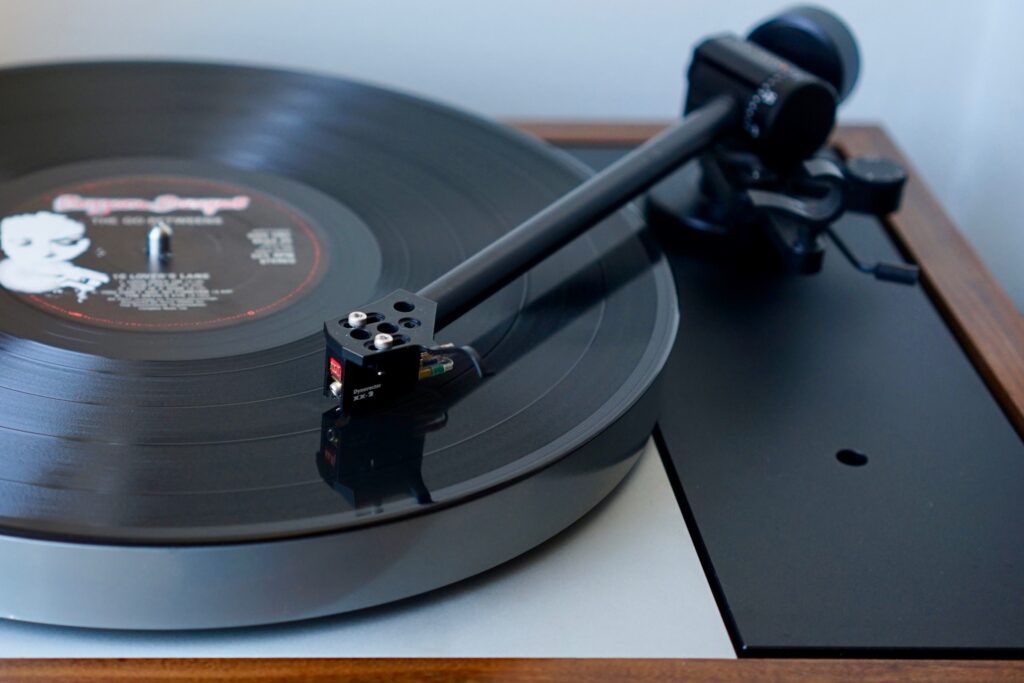
I’m also happy that this one has no logo on it; I prefer the logo-less look. There is an empty hole on the armboard, which is there to hold the arm rest for Ittok tonearms. I may want to fill that at some point; I know the old Linn MDF armboards used to come with little plugs to hide the hole. But a circle in a stark square armboard — I don’t know, it’s sort of modernist and cool.
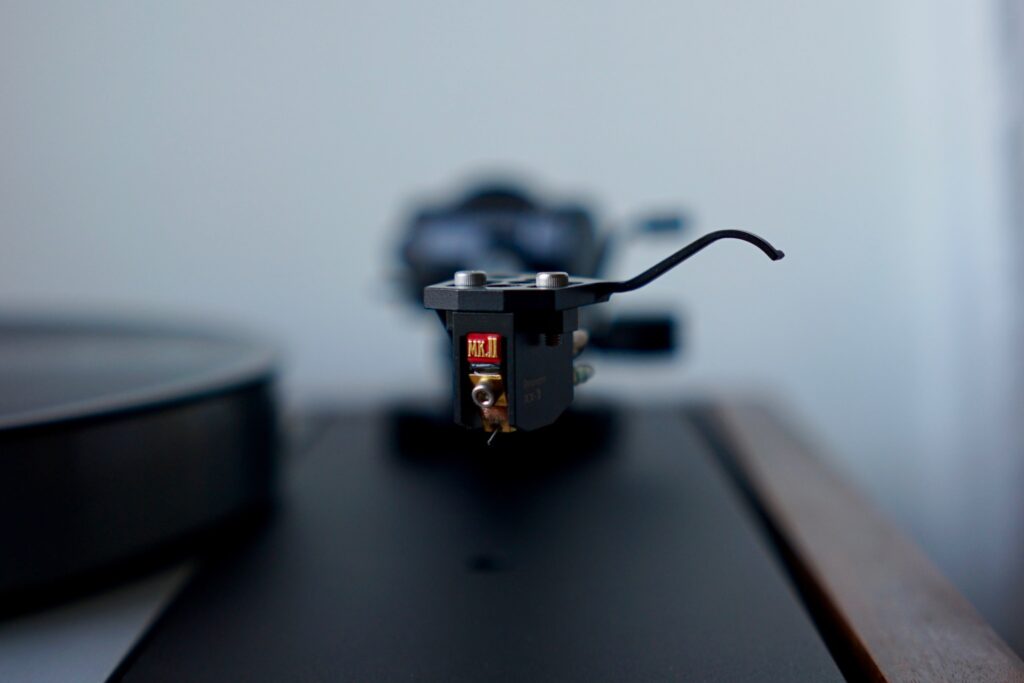
That’s just a cool photo that barely shows the Mober but which I thought looked very interesting. I’ll have to recycle it for something else at some point:
A wild goose chase on pinkfishmedia
I’m a fan of the community on the pinkfishmedia message boards. I’ve lurked in countless threads over the years and have learned a lot in the process. So I like to post links to my articles there in case they can add to the discussion.
On Thursday morning, I started a thread called “Disappointing experiences with a Dynavector XX-2 mkII, Linn Kore, and Ekos 2” in which I summarized my recent posts, noting the weird fact that a Kore/Ekos/XX-2 didn’t sound better than a Mober/Nima/Adikt and outlining some of the theories from my listening test.
Wonky Kore
I received a flood of responses, the vast majority of which were very helpful. A few people had thoughts on the bent Kore, including a few who are tired of hearing me complaining about my malfunctioning used gear. There were also a few really helpful replies, including one from Dan K, who proposed that Linn may have used (or their suppliers used) inferior aluminum on the machined armboard, of a type (rolled plate sheet) that loses its shape if not heat-treated or stress-relieved. Given the lack of any evidence that the Kore had been dropped, I think it’s a good theory. Here are two more images I took showing how bent the Kore is.
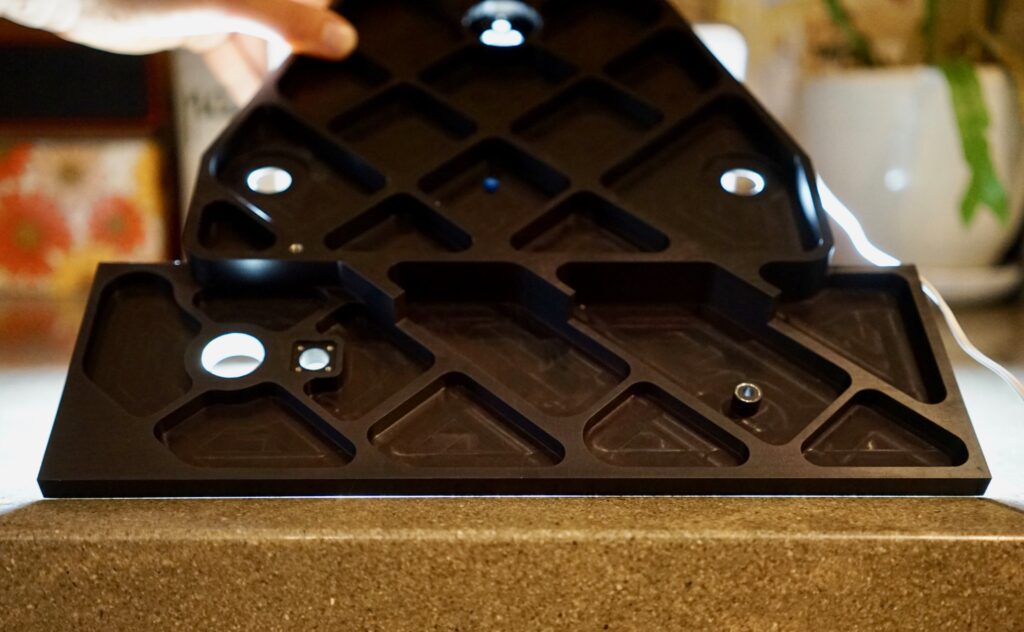
That’s my Greenstreet for Aro, lit from behind on my countertop, looking very flat.
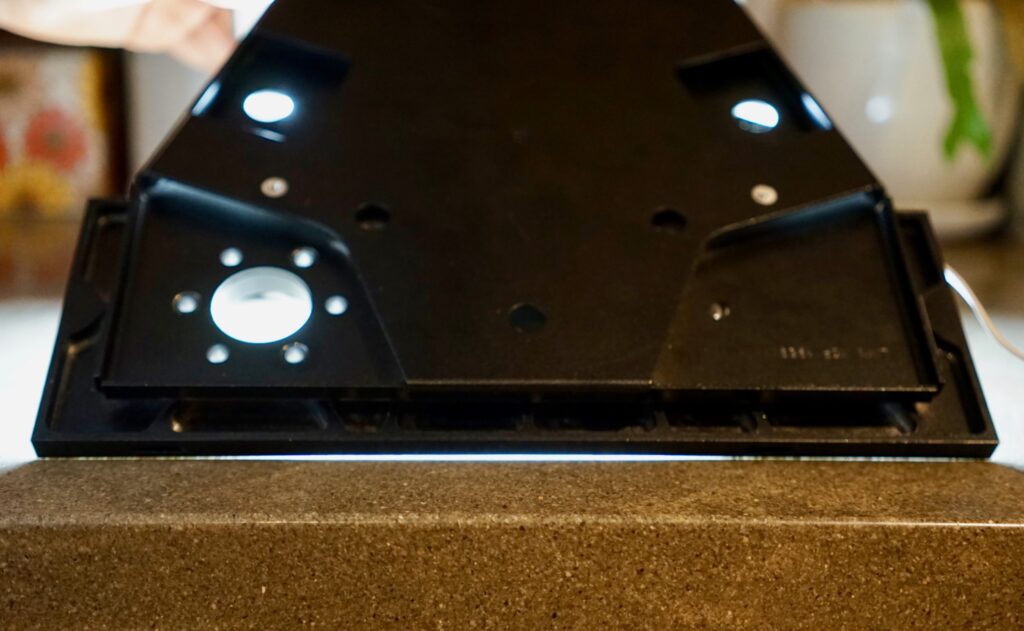
That’s the Kore, which exhibits a rather steady, smooth bow. Sigh.
Anti-skate
Most of the focus in the pfm thread was on the poor tracking results on the Hi-Fi News test LP, and various theories were advanced about worn cartridges and poor arm bearings.
Prompted by these comments, I looked for an alternate way to set anti-skate, and came across the Soundsmith method. The Soundsmith page said test records were useless, because they presented extreme cases unlikely to be encountered in actual listening and prompted you to set anti-skate way too high. That made sense to me. Their method also seemed to make sense: you should place your stylus in the space between runout grooves and adjust anti-skate until the stylus moves very slowly inward.
When I tried this, though, even with anti-skate on maximum, the arm would fly rapidly inward. I started to wonder if maybe my anti-skate dial wasn’t working, or whether “maximum” anti-skate (about 3.2) was less than it should be, like half a gram or so. Yet with anti-skate set to maximum, I could see that there was so much force being exerted that the arm was being pushed outward even against the friction of the cueing rest. I made this video to explain the apparent condundrum.
The immediate reaction on pfm was bafflement.
J7 to the rescue
In the meantime, I wrote to Johnnie 7 of Audio Origami, a well-respected (and, as I would learn, immensely friendly) manufacturer and repairer of turntable parts. We arranged to talk on Skype and he gave me his diagnosis. In his opinion, the Soundsmith test was flawed. The XX-2’s stylus is so sharp, he said, that it would actually cut in to the vinyl in those spaces between the runout grooves. That cutting action would create so much force that no amount of anti-skate could resist it. The test might work on different stylus profiles, but not for the XS-2. He had some concerns about the compliance of my cartridge — it seemed to be too stiff, to the bouncing across the surface of the record — but when I sent him a video of the cartridge coming to rest in the groove, he said it looked him. In his opinion, the XX-2 was fine and so was the Ekos and its anti-skate dial. In addition to really enjoying my chat with Johnnie, I was very relieved by his diagnosis.
Takeaways
Now that I’ve completed my listening test with the Mober subchassis, I think we have some evidence that he was right, and some clarity on the hypotheses I advanced in my last listening test.
- The Kore is the most likely source of the problem, either because it’s bent (thus throwing of alignment by putting the bearing and arm in different planes) or because it just doesn’t sound as good with the Ekos and XX-2 as the one-piece Mober.
- There doesn’t appear to be anything wrong with the XX-2 cartridge. Sure, I’d expect it to sound better than the Adikt, but I’m confident it’s not mistracking, anyway.
- The Ekos is fine: its bearings seem free of problems and its anti-skate seems to work as it ought to.
- Test discs are more or less useless; their “torture tests” are so far outside of realistic listening conditions that they lead you to make extreme, inaccurate adjustments, and performance on these torture tests is effectively meaningless.
- For cartridges with stylus profiles like my XX-2, the Soundsmith method for setting anti-skate does not work.
Notes on casual listening
I was so curious to know what was up with my previous configuration that I wasted almost no time in casual listening. I concluded Round Seven on a Tuesday, installed the Mober on a Wednesday morning, and did my first listening test that same evening.
I did, of course, still get a chance to do a bit of casual listening, and the results were very good. I was excited by the way the familiar records were sounding, especially Dave Holland’s A Conference of Birds. And I put on some records I hadn’t listened to in a while and was truly blown away. This was especially the case with Talking Heads’ Remain in Light (WOW).
Test tracks
I’ve decided to move to two-part “regression”/”improvement” numbers starting with this round: how much of a change since last round, then how far off best-ever performance.
1. The Beach Boys, “I Know There’s an Answer,” Pet Sounds (1966)
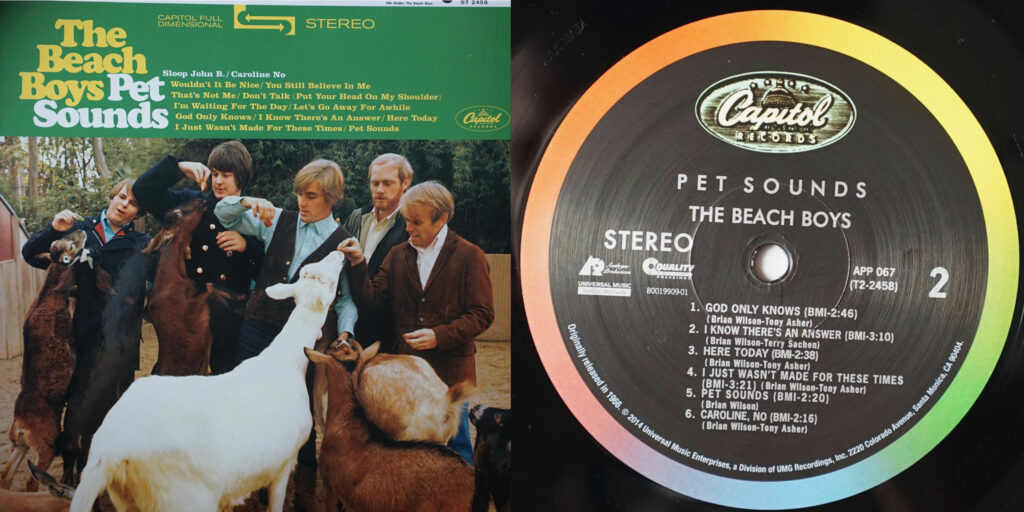
Full digital. This one does sound very nice. The “pbblt” detail near the start is great. I can feel the slight harshness, the timpani don’t quite thrill. Overall, not amazing, but definitely “good.” (Funny that this was one of my go-to “audio thrills” tracks in the digital days…)
Full vinyl. Texture, impact, slam — that’s what this combination does. It’s very “visceral.” There is a slight graininess to the presentation, probably the fault of the recording, and the timpani aren’t great here, either.
Slight delay. Immediate “gross” effect. Digital is so thin, tinny, off. The timpani aren’t amazing on vinyl but they are MUCH better (more impact, detail) than on digital. Bass in leadup to bass harmonica blast is much more distinct, in-focus on vinyl, and then the bass harmonica blast itself is just pathetically deflated on digital. Massive difference here.
S-2-s. Momentary differences are a little different. It’s the shakers that sound like distortion, all white without shade, on digital, and are much cleaner, better shaded on vinyl. Even the vocals have that effect, like they’ve been put through an over-exposure filter on digital. During the bass harmonica part, the ukulele (or whatever) in the right channel bleeds into the harmonica on digital, sits in its own pocket of space on vinyl. The question is 20% or 25%? “Gross” or “beyond gross”? Let’s flip the inputs and find out. Definitely 25% advantage to vinyl.
Verdict: vinyl is 25% better (5% improvement, 5% better than ever)
2. Charles Mingus, “Track B — Duet Solo Dancers,” The Black Saint and the Sinner Lady (1963)
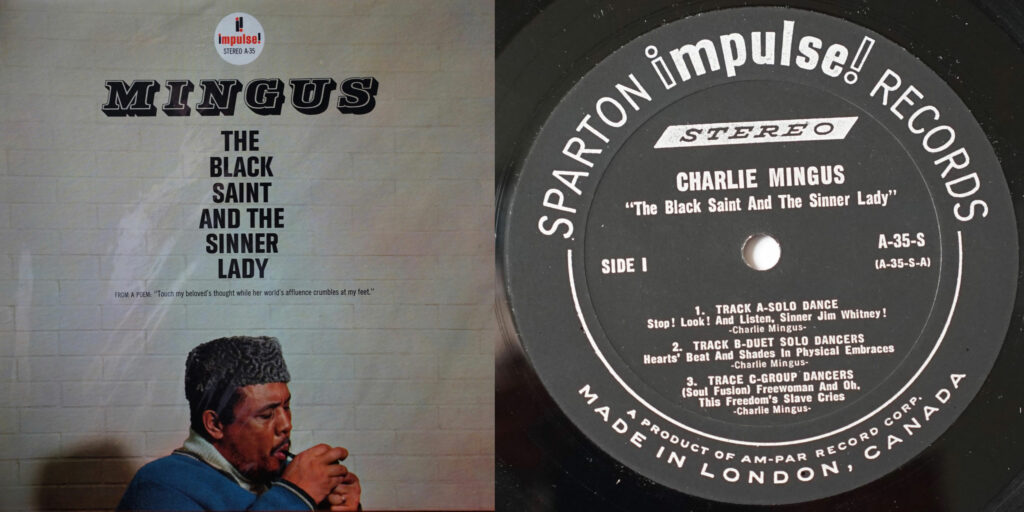
Full digital. Now this doesn’t sound better than usual. It sounds tinny, the soundstage seems unnatural, the presentation is harsh and unpleasant. Having said that — nice impact on the buh-buh-buh-buh-buh, the cordy sax has nice texture, there’s plenty of detail…
Full vinyl. Really, really nice. Tons of details, tons of impact, really engaging, smooth presentation. I’m really settling into the sound profile of the XX-2/Ekos combination and I’m really enjoying it. Definite audio thrills on the texture of the cordy sax. I’m absolutely sure this is the best I’ve heard this pressing sound.
Slight delay. In direct comparison, it’s the screechy, tinny cymbals on digital that stand out — softer, more graceful and nuanced on digital. The force and impact of digital is terrific, and I think vinyl still might be a step behind, but in tonal balance the vinyl is far ahead. Definite “gross” territory during the loud parts: the grating, piercing, tinny cymbals ruin it and make it hard to listen to on digital. So smooth and thick (at the same time!) on vinyl. So 15-20%, with moments clearly in 20% range.
S-2-s. Yep, no doubt: GROSS throughout. It’s the tonal balance, the width, and especially those horribly, tinny cymbals. The force is definitely there on digital, but not texture or delicacy or width of soundstage.
Verdict: vinyl is 20% better (5% improvement; 5% better than ever)
3. The Pentangle, “Let No Man Steal Your Thyme,” The Pentangle (1968)
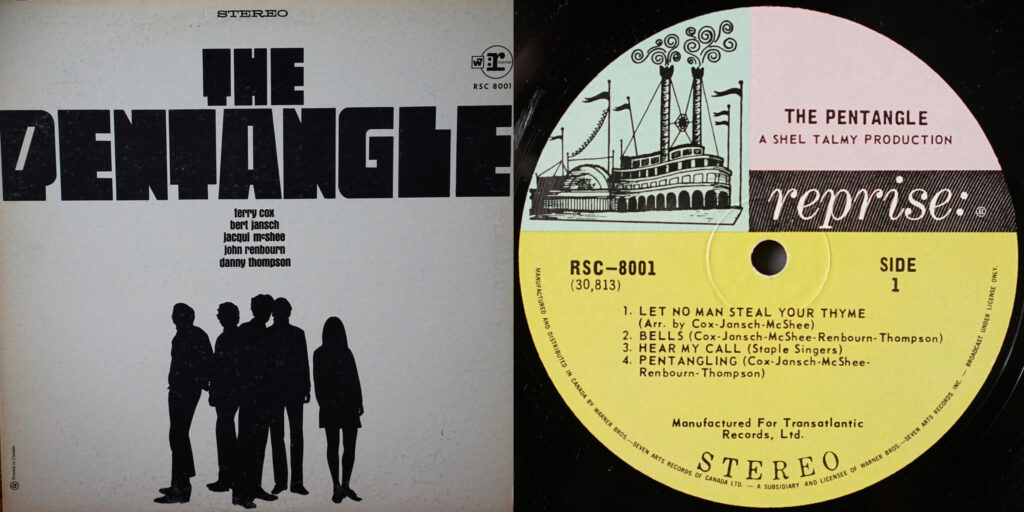
Full digital. Getting that “hmm, this sounds better than usual on digital” feeling I’ve been getting a lot lately… Hmm! Lots of detail, lots of texture, lots of separation and nice soundstage. Very enjoyable.
Full vinyl (only the Reprise today). Similar detail, etc, but will a fuller, weightier, richer sound. Very nice detail on the triangle/bells and springiness in the guitar during the quiet part. Surface noise is not particularly annoying — better than usual.
Slight delay. Nicer textures on vinyl, less harsh, fuller — and a bit wider, too. The quiet part is really lovely on vinyl. On digital, the triangle dominates the soundstage and is very harsh. Much more balanced and engrossing on vinyl. On the closing bowed bass, just a little nicer on texture on vinyl, and the tone (less bright; richer) seems more accurate, more like a bowed bass!
S-2-s. Yes, that’s it: the bass sounds more like a bass, the guitar sounds more like a guitar, the voice more like a human voice. Without the exaggerated edge of treble on digital, much more “natural,” nicely balanced, real. Does feel close to “gross” territory, but not quite. Solid 15%. (Notably, the next track on the side sounds much less good, quite muted in comparison. Maybe all the play this track has been getting has actually cleaned out some crap from the grooves and made it sound better!)
Verdict: vinyl is 15% better (5% improvement; 5% better than ever)
4. Mariah, “Shinzo No Tobira,” Utakata No Hibi (1983)
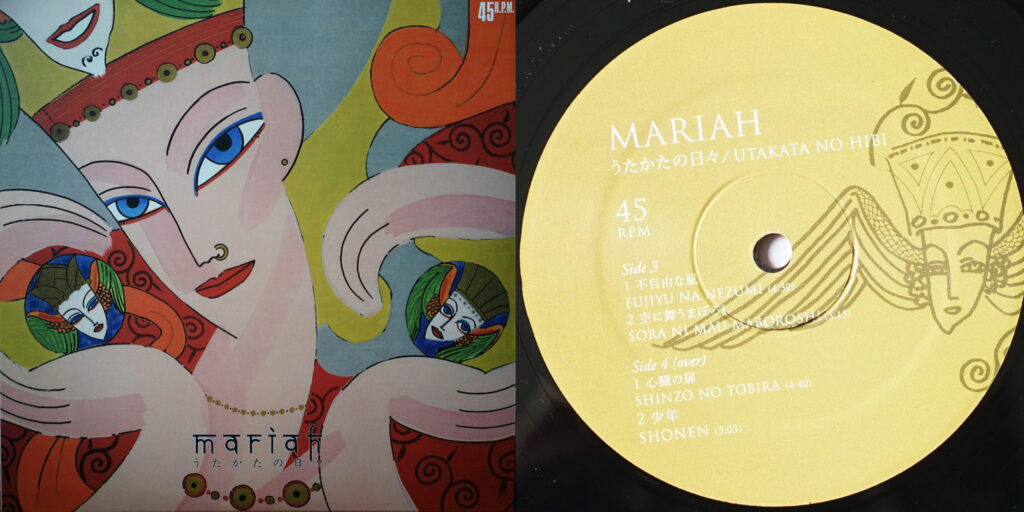
Full digital. Again, I have the weird impression that the digital is sounding a little better than usual. Good bass, good detail on the rattles.
Full vinyl. I’m getting more impact, more of a sense of whatever wooden thing is actually hitting that rattle. More impact from the kick drum (or whatever that is) in the background. Then when the heavier drums kick in, lots and lots of slam. No doubt, the XX-2 and the Ekos like to rock. Really lovely combination of detail and slam, impact. Pleasant and not harsh.
Slight delay. A bit more detail on the shakers on vinyl, but the real difference is the impact of the bass, especially once the drums and bass tones kick in. The timbre of the lead vocal is also clear, much more pleasant on vinyl. We’re in 25%ish territory here. Synths are much crunchier, more vivid on vinyl. Big difference there.
S-2-s. Subtle sounds (“doo-DOO” vocals, synth washes) are clearer on vinyl in the intro. Much better texture on the snare on vinyl. But the big difference are the deeper drums, which are much more palpable on vinyl, without overwhelming the treble details. The balance is just right on vinyl, and all the details are much, much sharper. Big win.
Verdict: vinyl is 25% better (10% improvement; equal to best)
5. Joy Division, “Atmosphere,” 12″ single (1980)
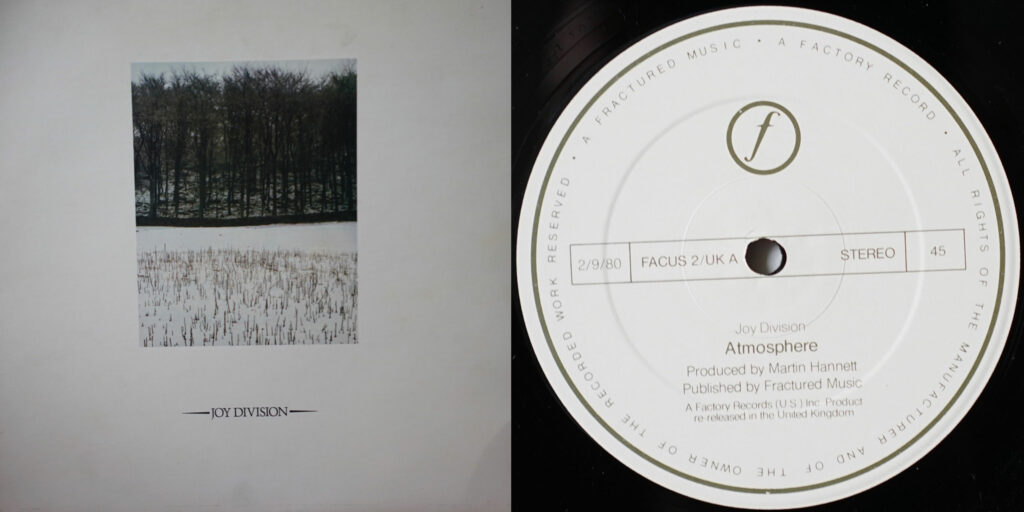
Full digital. And now the test I look forward to… and dread. This is where the differences are really heard. If I had to pick only one song or recording or band on this list, it would be this. Here we go. Okay, yeah: pretty good but nothing special. I know this very well on digital.
Full vinyl. And…. OK! That is very, very, very good. It’s possible I’ve built up a distant audio memory into something unattainable — it’s also possible that putting in a power conditioner has helped the digital more than the vinyl, or a Roon update has helped or something, so the comparisons have changed — but this sounds extremely good while also leaving me thinking it could sound better. Direct comparisons might be more helpful.
Slight delay. Definite wow factor. I’m convinced that the digital is sounding better than usual — but the vinyl is just remarkable. It’s the separation of the instruments in the space, the huge, immersive soundstage, and the beautiful lifelike timbre, especially of the hand drum on the right. It’s all there on digital, it’s just that the tones and timbres are off and lacking. Most important of all, Ian Curtis’s incomparable voice just comes through more clearly in vinyl: no film; right there. Best I’ve heard this track in a long time, if not ever. I’ll only say 25% better, because the digital is really not that bad, but this is truly impressively good.
S-2-s. I do think the digital has somehow gotten better. But the vinyl is just astounding. Switching from digital to vinyl, all the confusion vanishes: everything is in its place, everything is in focus. Just a beautiful experience. I think it’s only 25% better than digital, but it sounds incredible, and I bet about as good as it’s ever sounded. Amazing, amazing, amazing.
Verdict: vinyl is 25% better (5% improvement; 5% off best)
6. Low, “Just Make It Stop,” The Invisible Way (2013)
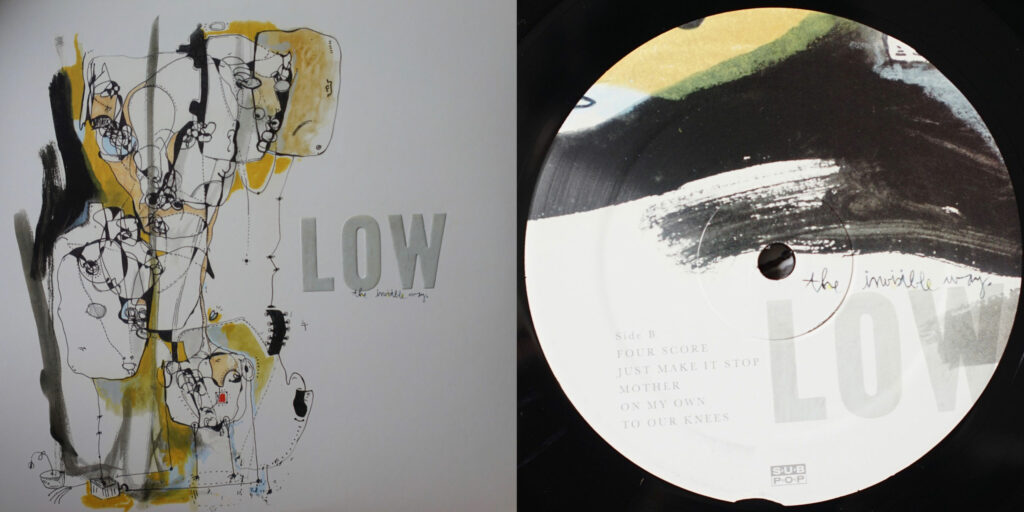
Full digital. Man, this track is sounding really good today on digital, too! Maybe it was a Roon update or something. I’m especially impressed by the delicate cymbals, though those seem to retreat and lose their distinctness in the busier parts. The piano doesn’t hit with particular clarity.
Full vinyl. A little bigger, broader, richer. Mimi’s voice has no sense of constraint on it, a common complaint in previous rounds. Yes, this is really nice. So much nice bass impact and force, especially on the guitar palm mutes. And indeed, these cymbals are a little more delicate and don’t lose their distinctness as things get busy. Plenty of impact and clarity from the piano. This sounds terrific. Another deeply pleasant listening experience. The Mober subchassis has made a big difference versus the wonky Kore.
Slight delay. Timbre of the cymbals is off on digital, and more gratingly, timbre of the snare is off. Mimi’s vocals are constrained, covered, too bright, grainy. Soooo much smoother on vinyl. The drum sounds are just absolutely right, clear but not harsh. 25% territory.
S-2-s. SUCH great sound from vinyl — so full and spot-on tonally. Cymbals, Mimi’s voice, the palm mutes — all presented so beautifully on vinyl, so much more clearly and with so much more impact that digital. Chalky, out of focus, confused on digital. I’m not having an out-of-body experience or anything, but this is REALLY good.
Verdict: vinyl is 25% better (10% improvement; equal to best)
7. Yo La Tengo, “Stockholm Syndrome,” I Can Feel the Heart Beating as One (1997)

Full digital. The backward listening test continues; this group of three (YLT, Beatles, Dungen) is the second I’m doing. Am I crazy or does this sound quite a bit better than it usually sounds on digital? Those acoustic guitars are really relatively crisp…
Full vinyl. Oh yes: way more life and texture here, lots more bass, much more focus. The acoustic guitars sound sharper, definitely. As massive a difference as 35%, the record for this track? I wouldn’t think so. But definitely really good. This is why I’m doing this whole insane time-consuming LP12MF: to hear my favorite songs sound this good. The next track, “Autumn Sweater,” starts with some massive bass drums and some sharp, soft cymbals: very, very nice, too. Ira’s voice sound excellent here too: the throaty texture is all there, set beautifully in space behind the huge drums and the organ.
Slight delay. Huge, huge difference here. Mostly in the acoustic guitars, but also the overall clarity. There’s a thick veil over James’s voice on digital. Well beyond gross here in terms of a comparison. And the joyful drums, so deep, on the solo. Just full of life. I think the snare might be coming through slightly harsh on vinyl, though… So more than 25% — probably 30% better? Obviously my numerical system is not terribly precise — this could easily be 35%. But I’ll call it 30%. Amazing, and a very clear improvement over last round.
S-2-s. Definite WOW factor. I can imagine it sounding a little better — the snare is a little flat and harsh — but this is a beautiful presentation: bouncing, driving, percussive, dynamic.
Verdict: vinyl is 30% better (10% improvement; 5% off best)
8. The Beatles, “While My Guitar Gently Weeps,” The White Album (1968)
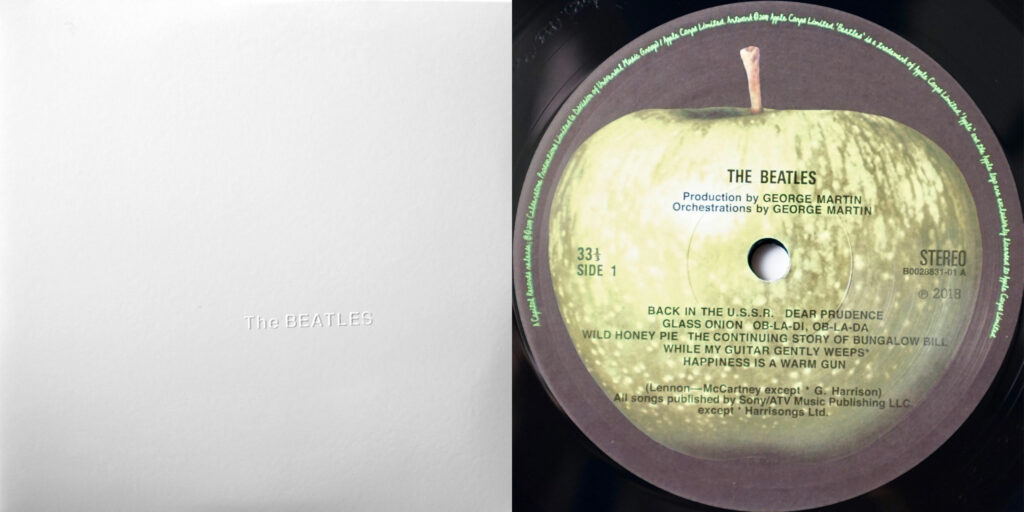
Full digital. Just not an enjoyable presentation: so much harsh treble. There’s a lot of bass, but the “sucking-ear” sensation I’ve gotten in previous rounds is very palpable and super annoying. Perhaps technically adept but really not enjoyable.
Full vinyl. Much smoother. The acoustic guitars have tons of detail, the bass has tons of heft, there it a lot of nice cymbal treble, and it’s never harsh or grating. I’m sure I’m getting better treble detail this round that I was getting last time. The “clippety-clops” are the best I’ve heard them. I don’t think I’m giving up anything to get the huge, full depth of the bottom end. Last time, there was a tradeoff.
Slight delay. Vinyl wins everywhere. Major difference: bass drum and bass guitar, both huge and full; switching to digital is embarrassing. Guitars are sharper, as are the clippety-clops. Resounding win. I might have said 25% if I wasn’t so sure this sounds better than it was last round…
S-2-s. As above. You know maybe I could use the acoustic guitars a wee bit further forward. I’m going to keep this one as a 25%, because in direct back-to-back I’m just having the devastating experience I should for a 30%. I’m sure it’s better than last time, but I’m going to give it the same score.
Verdict: vinyl is 25% better (no improvement; 5% off best)
9. Dungen, “Panda,” Ta Det Lugnt (2004)

Full digital. Okay, I’m listening to these opening drums and getting ready to be really blown by the vinyl setup, which I hope is finally getting back to its glory days. A little harsh, really. I don’t love the sound I’m hearing. And, hey, sibilance — on a digital track! At least I don’t need to worry about my anti-skate…!
Full vinyl. Yes, that is GOOD! Just turned it up way too loud — always a serious danger with this track — purely because it sounded so good. I’m having something like my best experience with this song — it’s all huge and wide, with the acoustic instruments on the outside (drums) making space for the ray of distortion in the centre (guitars)! But I think I’ve heard it better. One little notch down from the best. But very, very good.
Slight delay. Absolutely massive advantage in the drums at the opening. So much more impact, depth, and sense of realism. The digital drums sound like Jamaican steel drums — shallow and flinty.
S-2-s. Again, I have the sense it’s a little better than last time, but I hesitate to say 30% better. So much more drive, impact, and detail on the cymbals and drums. Much rounder, livelier. The audio mushroom cloud at the end is massively more detailed and impactful. But I’d still just say 25%.
Verdict: vinyl is 25% better (no improvement; 5% off best)
10. Julee Cruise, “Rocking Back Inside My Heart,” Floating Into the Night (1989)
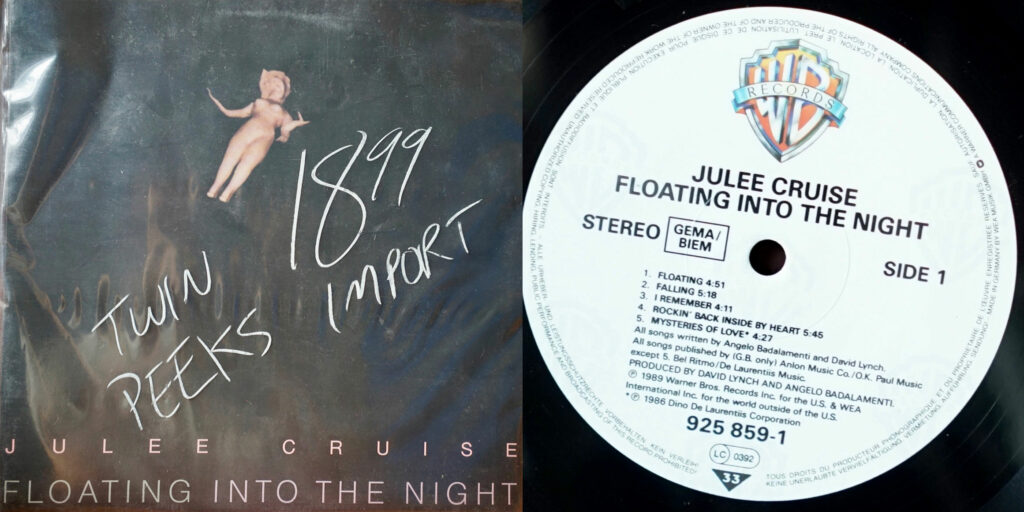
Full digital. In an effort to quickly get a sense of what difference the Mober subchassis has made, I’m starting with Julee Cruise this time — and listening to three tracks I gave listening tests to last night. I’ve never gone back to back within 24 hours. So: I’m listening to this digital track that I just listened to yesterday, focusing on its okay-but-not-amazing palm mutes and sax blasts…
Full vinyl. Oooh, the palm mutes are really good! The little piano dinks are also really nicely clear. This sounds really, really good — excitingly good.
Slight delay. Yeah, those palm mutes. No fancier way to say that that they sound better, like the guitar is right there, like it’s in the room. And the sax blast is just stunning here: I’m sure as good as I’ve heard it. The digital doesn’t sound bad, but the vinyl sounds remarkably good.
S-2-s. Digital is very dry in comparison. The vinyl is very juicy and full and and detailed. Definitely more bass, but I don’t feel any treble detail is being sacrificed here. 25% better for sure, maybe 30%.
Verdict: vinyl is 25% better (5% improvement; equal to best)
11. Can, “Halleluwah,” Tago Mago (1971)
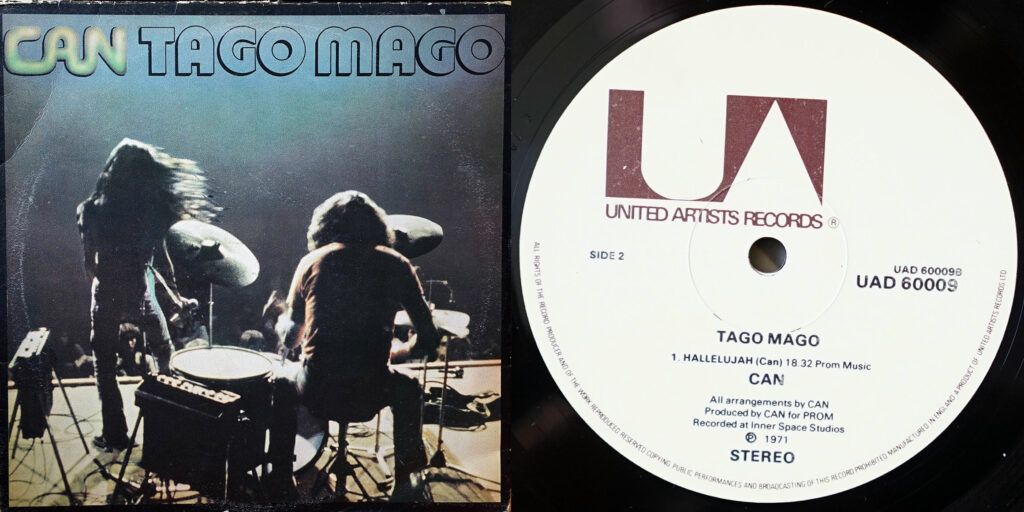
Full digital. Okay, I won’t listen to the whole track, but I’ll re-acclimitize myself to the first couple of minutes. You know, it really doesn’t sound bad… Let’s see how it is on vinyl.
Full vinyl. Immediately much, much better — livelier, fuller, more natural. The bass is absolutely massive. Wow, when the louder drums come in, it’s really impressive. Let’s get them synced up and do some slight delay…
Slight delay. I’m hearing a much, much bigger difference than yesterday. These drums are killing on vinyl — they’re like “Atmosphere”-good! So full and massive. Wow. Definitely the best I’ve heard this song.
S-2-s. Everything about this is amazing. SO much drive, and the details (including the tickle sounds) are just absolutely perfect. The cymbals and transients are much clearer and crisper on vinyl. I have that sense of excitement back. Spatial details are amazing: I’m in the room. So much harshness on digital — no, I want to go right back. Reading back through my notes on the S-2-s from the superb Round Five, it’s clear this is sounding more impressive here than before. So it’s a 30%. Totally don’t want to stop listening: this is one of my favourite ever tracks, and I’m hearing it like I never have before…
Verdict: vinyl is 30% better (10% improvement; 5% better than ever)
12. Bill Callahan, “Javelin Unlanding,” Dream River (2013)
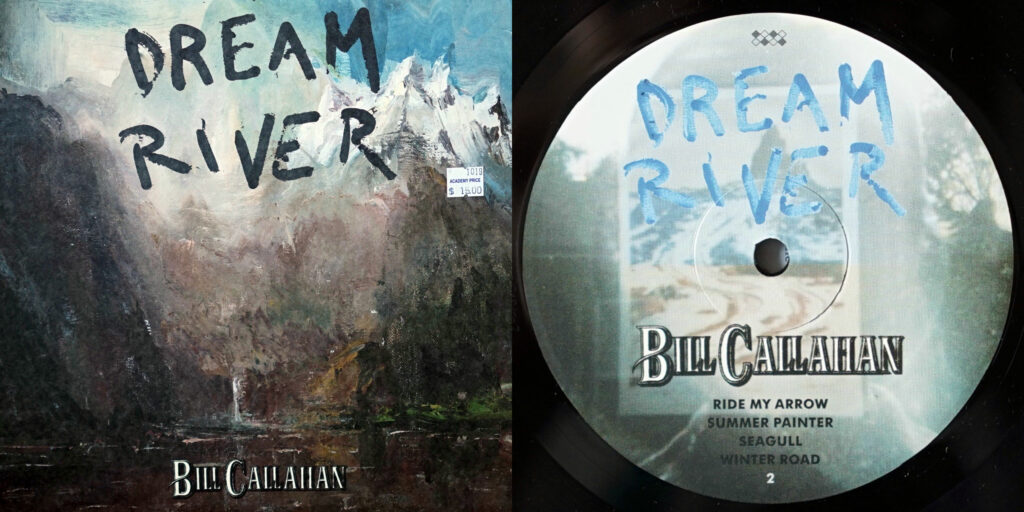
Full digital. Boy, do I hope this sounds better on vinyl that last night. I haven’t been enjoying listening to this track. Really doesn’t sound great after the high highs of Can. All that weird pixel-barf around the voice and acoustic guitar (which I really am beginning to suspect is just part of the recording) — but the hand drums also sound really flat, bleh.
Full vinyl. The vocals are way clearer here. The hand drums are clearer too. I can hear all the shitty contours around the voice — I can see exactly wherever that annoying pixelly effect was put on his voice. But beyond that is actually nice width. Yeah, the guitar and the hand drums (and the bass) actually sound good here, for the first time in a long time. This isn’t a totally horribly chosen test track. Clearly another big improvement here. I’m actually enjoying listening to this track. Shocker.
Slight delay. Big difference. There’s a really audible moment in the song on vinyl where the crappy, dinky sounds make way for the good sounds — like a crapiness dial is being turned slowly down. On digital, the dial is never turned. It just stays crappy.
S-2-s. A whole lot better. Definitely 25%. Reading back over my notes, I sort of doubt my previous 30% in Round 5. But I don’t think I’m quite there… It’s not THAT much worse on digital. But the fact that it sounds so good on vinyl is a new feeling. Just listening to a little guiro sound I’d never noticed before, and which really doesn’t show up on digital unless you’re specifically looking for it. I’ll say 25% while also saying I genuinely don’t think I’ve ever heard this track sound this good.
Verdict: vinyl is 25% better (5% improvement; 5% off best)
Next steps
At times, I worried that the next step would be sending off the Ekos tonearm to have it repaired or having an expert look at the XX-2 cartridge. Thankfully, I’m fairly convinced they’re both fine. So I can proceed with my plan.
As I write this, I’ve already taken the next step: installing the Mober DC motor kit. Indeed, I’m about to write a post about the installation process…

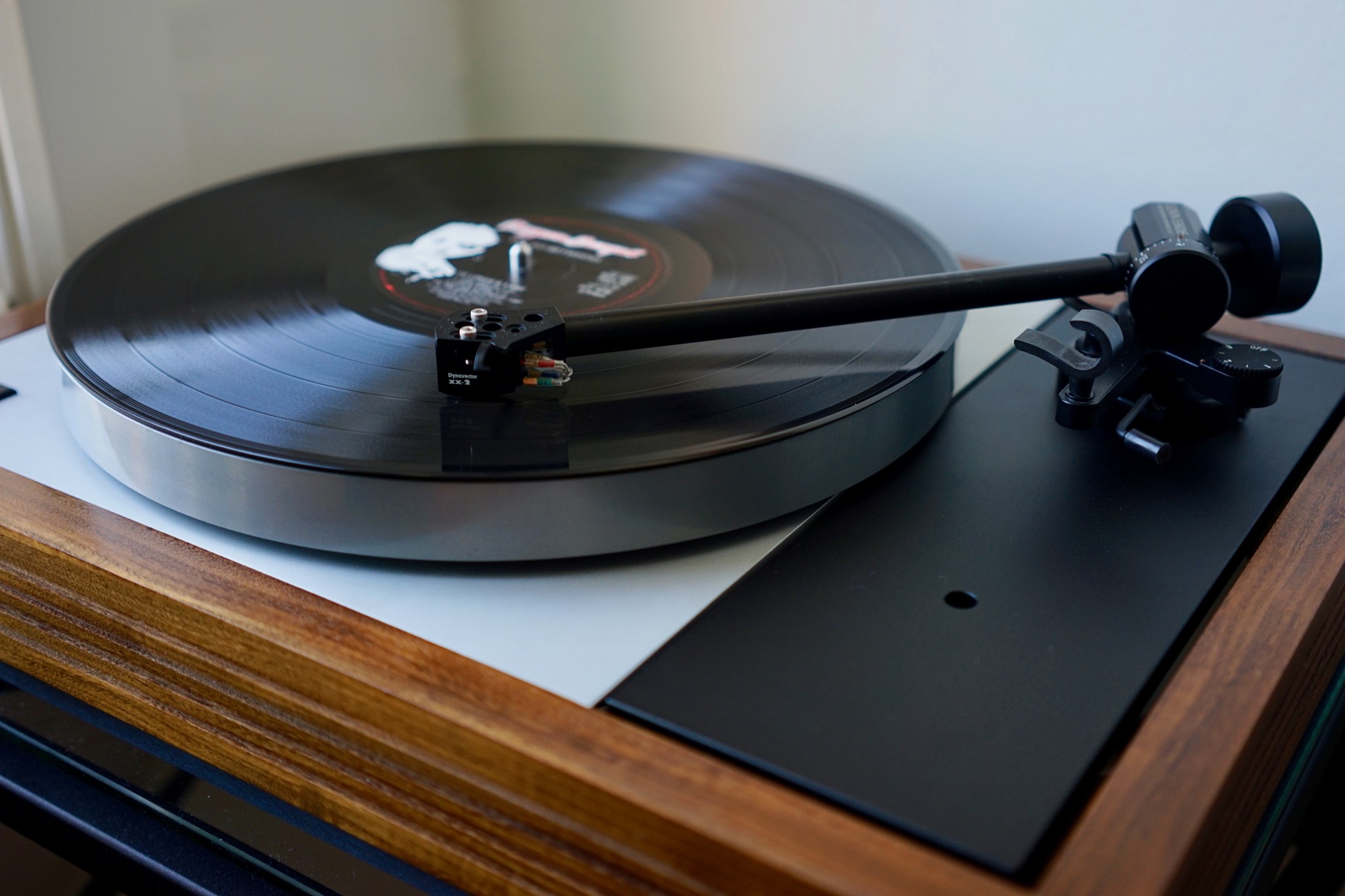
2 Comments
Join the discussion and tell us your opinion.
You mentioned using a power conditioner. I added one to my digital system, which was sounding pretty good prior to its installation. My findings, using it on the music server, really quietened thinks, I was amazed. It also made an improvement when used with other components, but removing the switched power from the server was not subtle!
I totally agree: having been VERY skeptical at first, I am now convinced of the important of various power conditioning devices — especially for digital, actually. I wrote about this here: https://www.hifiaf.com/power-conditioning-shootout/